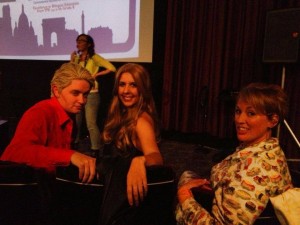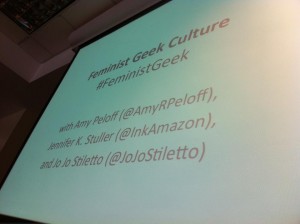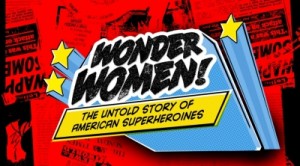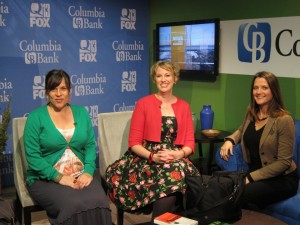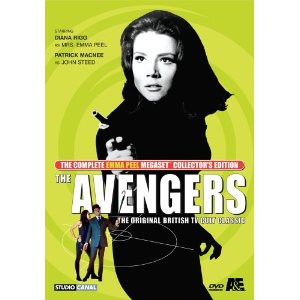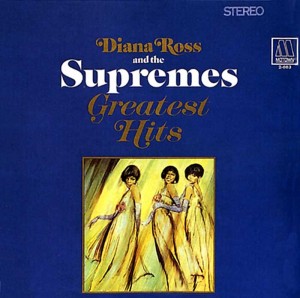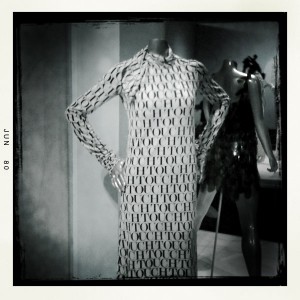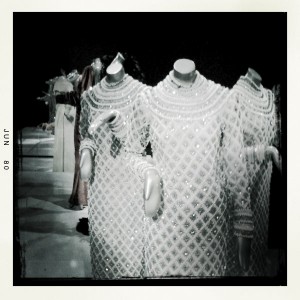Some thoughts on GeekGirlCon ’13 + A Post-Event Round-Up of Community Impressions
Jennifer K. Stuller on November 19, 2013 in Uncategorized No Comments »The Monday after GeekGirlCon ’13 I posted the following on Facebook:
You know . . . I think I’ve exchanged the words “I love you,” “I’m proud of you,” and/or, “You amaze me,” with more women in the past 72 hours than I have in my entire life so far. It feels really fucking good.
Before GeekGirlCon, I’d never been part of a female community before – even as a self-identified feminist. Being part of this organization with our passionate, committed, and hard-working all-volunteer staff, and the enthusiasm, support, and collaboration of our extended community has been enormously healing for me – as well as a source of personal and professional growth.
This year’s convention event went above and beyond to create an inclusive and diverse experience, both in terms of identity politics and genre or thematic interests. We bridged academia with career advice, nerdlesque with puppet shows, and cosplay with social justice issues. We had gaming, art, science, and crafty-vendors. The design was beautiful, operations kept things running smoothly, and marketing generated enthusiasm while keeping our public informed. The celebrations and the conversations were phenomenal. We had more programming, panelists, and attendees than ever before. Through year-round programming & events, and some damn fine marketing, we increased our audience by 50% over last year’s convention – and actually sold out before doors opened! And knowing my ambitious GeekGirlCon family – we will strive to be ever-better.
* * *
In the past, people have described the experience of GeekGirlCon as “warm,” “safe,” and “inspiring.” And this year these words were repeated again and again.
For GeekGirlCon ’13, here is a select collection of post-event thoughts, wrap-ups, and suggestions for improvement from press, attendees, staff, and contributors.
GeekWire – “GeekGirlCon: Where you can be whatever you want” by Emily Shahan
“In fact, above all else, it seems to me that acceptance is the main focus of GeekGirlCon. This is apparent from the curated panels to types of vendors and artists on display. . . . the classic nerd stereotype is changing as more women, LGBT folks and people of color step forward and claim their space in Nerd-dom. We are demanding that the media we love so dearly reflect its fanbase — that there are more stories to tell than that of the white, male hero.”
“Is nerd culture fragmenting along dominant-minority lines? Will underrepresented voices retreat to their own spaces or continue to push the dialogue forward in fandom’s most populous arenas? . . . Though it is oriented toward women as a deliberate strategy, [GeekGirlCon] in practice represents the very opposite of ‘separatist’ fandom and aims to be an inclusive space where geek dads can bring their daughters and geek moms can bring their sons without the implicit biases that color interactions at other kinds of cons.”
“A couple things on my return” by Sigrid Ellis
“I have no insider knowledge of how Geek Girl Con is run. I don’t know any of the organizers. But, damn, y’all, that operates like a finely-run fan convention. It was like a professional media or comic-con, except run by cheerful, enthusiastic, friendly volunteers who all cared enormously about what they were doing. . . The thing I will remember most about Geek Girl Con is how HAPPY everyone was to be there, how HAPPY everyone was to see everyone else and to all be doing this awesome thing, together, at the same time.”
“[W]hile it’s still more intimate than many of its established cousins, in its third year, organizers should have considered renaming Geek Girl Con ’Katniss,’ because the ‘Girl’ was on fire.”
GeekMom – “Why GeekGirlCon Is Uniquely Satisfying” by Corrina Lawson
“I went expecting a regular-style con only with more women. What I found was a community basically throwing a huge getaway weekend. Instead of being exhausted at the end, as I feel like at most cons, I left energized and excited about the future.”
Through a City Geekly – “GeekGirlCon: A Geekly Recap”
“The message I heard over and over again as I spoke to attendees was clear: this is a safe space. As women have increasingly become a part of ‘geek culture’, the harassment they face has also increased. And women who want to work in the comic or gaming industries, or, heaven forbid, who want to be scientists? That’s an uphill battle of Sisyphusian proportions. Yes, thankfully, the game is changing and slowly — so, so slowly — the opportunities are starting to emerge. Organizations like GeekGirlCon are part of that solution.”
“GeekGirlCon 2013” – by Anne Bean
“How do I describe GeekGirlCon? Do I talk about the gender distribution: maybe 75% women, 25% men? Do I talk about how much more visible queer geeks, geeks of color, and geeks with disability were than at other cons? Do I talk about the high quality of cosplay, the seriously good panels, or the interesting bits that other cons don’t have, like the DIY Science section or the networking section? . . . There are important conversations about women and race and disability and all kinds of neat things! There’s a lot of rad cosplay! There is actual science! There is a non-creepy vibe! . . . It is a magical place.”
Fangirl Confessions – “GeekGirlCon 2013 Wrap Up”
“The most beautiful thing about cosplaying at Geek Girl Con is that the cosplayers come in all shapes, sizes, ages, colors, sexual orientations, etc. The cosplaying community here is respectful of each other. I felt as if I were a part of something special. . . . I have never felt so included in an event as I have here. I felt as if I had just dropped in on some old friends, even though this was my first Geek Girl Con and I was attending alone. I might have showed up alone, but I am leaving with a ton of new friends.”
“You’re Welcome Here: Geek Girl Con 2013” by Elicia Sanchez
“[R]ight at that moment, it hit me. That special indescribable feeling of security and safety that comes over you when you realize you’ve just stumbled upon a safe space where you can just be you. . . . A feeling of belonging and acceptance, like a huge sigh of social anxiety relief. It may seem to some as a stretch to equate a sticker photograph policy to an encompassing feeling of acceptance, but it really was just my first reminder that not just women, but all geeks were free to be themselves here without the leering eyes of some creeper trying to gawk at tight or suggestive cosplay or some asshole trying to get a picture of a fat ‘slave Leia’ to make mockery of on Reddit. I immediately realized this may not be your average nerd gathering.”
“There were far more men at GeekGirlCon than I expected and they participated at every level: on staff, on panels, and as attendees. And yet GGC people also spoke of the con as a Safe Space. Again, the idea of what is safe differs depending on what type of woman you are, yet I was pretty confident that there wouldn’t be anyone there saying that they ‘want to buy an umbrella [that comes] with an Asian girl,’ no matter the gender. It’s not about banning or even discouraging guys from coming to the con, it’s about making it clear what is and is not valued that leads to a con women can feel safe attending.
So forget any ridiculousness you hear about how cons that cater to specific or marginalized groups are all about self-segregation. They’re not — not completely. Because if the con has all the elements geeks flock to cons for, it will attract all the geeks. And if these cons can attract geeks away from events that foster a hostile environment, then those other cons (and the media entities that support them) will either have to change or die.”
Burlesque Seattle Press – “Bechdel Test Burlesque” by Paul O’Connell
“To understand GeekGirlCon’s perspective, Jo Jo says that she went straight to the source: Jennifer K. Stuller, Director of Programming and Events for the annual conference. ‘We love strong female characters and we love them even more when they are complex and we believe that performance provides opportunities to tell new, challenging and inspiring stories about our favorite female characters and their allies.'”
Fangirl Blog – “GeekGirlCon 2013: Convention Recap” by Tricia Barr
“Once again this year’s convention was a delight. The staff is friendly, the panels enjoyable and enlightening, and the venue is top-notch.”
Geekquality – “We’re Back from GeekGirlCon!” by Tanya
“At the convention, there were a lot more parents with young children, as well as teenage geeks this year. Many times I overheard kids excitedly discussing their favorite comic book characters or games, and it reminded me just how fun it is to discover your hobbies and interests for the first time. There is something really moving about seeing so many young people in a comfortable space where they can feel at ease, while also bonding with their parents who brought them to the Con. That enthusiastic, playful energy wasn’t just limited to the younger set, as plenty of geeks and nerds of all stripes came to GGC, making it a completely sold out event both days.”
“It’s amazing to see so many women together, contributing to and creating a woman-friendly environment where people can openly speak about their experiences in their field. Many men come to the Con as well, supporting not only their mothers, sisters, friends, wives, and girlfriends, but also showing support for female-created works and incorporating those pieces into their own lives. There is room for both women and men in all these industries. . . . But most importantly, GeekGirlCon is a stepping stone for young girls looking for their voice by being able to interact with women who have found their own voices already.”
Almost Nerdy – “GeekGirlCon: A Growing Celebration of Female Geeks” by SIERRA HOUK
“The inclusive environment that GeekGirlCon creates is a lovely thing to be a part of. Panels ranged in topics from race, consent, and body image in regards to cosplay, self-publishing tips, how feminism is reflected in nerd culture and what it means to be a female nerd, to craft competitions and a fully improvised parody of classic Star Trek episodes. There was something there for everyone, no matter your gender or fandoms. It was obvious that everyone there wasn’t afraid to hold back, whether they were cosplaying as their favorite Batman villain or singing along with one of the nerdy musicians putting on a ninja gig (see: The Doubleclicks pleasing the crowd at their lobby show).”
The Backup Ribbon Project – “Coming Home: Geek Girl Con 2013”
“At Geek Girl Con, found myself connecting with random people with whom I was standing in line to wait for a panel. People told me their stories, asked for ribbons, and gave me their contact information. It was, in a word, overwhelming to see an entire con — including the staff and con com — committed to making geek spaces accessible for all. . . . In two days at Geek Girl Con, I felt more a part of the geek community than I have in more than 20 years of geekdom.”
WatchPlayRead – “My Adventures at GeekGirlCon 2013! Real Geek Girls, Seriously!!!” by Becky Hansen
“Attending GeekGirlCon gave me a feeling of empowerment, a feeling of respect for my contributions, and those of other females, to the world of geek. One of the greatest parts of the con was seeing women of all ages coming together to stand up for geek girls everywhere. There were girls as young as 5 getting dressed up as their favorite characters. An immense confidence filled every nook and cranny of the convention center.”
“While Geek Girl Con has its roots in the experiences of mainstream comics conventions (see the organization’s About page), the event is not, specifically, a “comic-con”. The convention’s tagline, “The Celebration of the Female Geek”, points to this broader mission, which is to provide a safe and welcoming space for women and girls to share and express their geeky pursuits, whether in the lab, at the X-Box, or in the pages of a comic. . . .Other comics conventions will feature academic panels, even parallel academic conferences, and there are, of course, actual comics studies meetings, but I can’t think of another gathering of academics, practitioners, and fans that places comics alongside not just other pop media, but also science, math, and technology. . . .More importantly, unlike other conventions, which are largely promotional in nature, whether from a corporate perspective or that of individual creators, Geek Girl is rooted in the desire for a critical unpacking, interrogation, and re-construction of the category ‘geek’ in a way that is more open and inclusive than is normally possibly in the predominantly male spaces through which fields like comics, computer programming, and video gaming are defined.”
Suvudu – “GeekGirlCon 2013 Wrap Up” BY THALIA SUTTON
“GGC offers a safe place to discuss issues that women face, but upon attending I found that its programming tackled every highly-visible issue within the geekosphere, including bullying, women’s empowerment and equality, minority issues, portrayal of physical disabilities, geek parenting, geek children, cosplay and fashion, and freelance vs. corporate work, just to name a few. Whereas New York Comic Con the week before was a sink-or-swim atmosphere that continued to carry the apparent flag of ‘industry not issues,’ GGC was the stark reverse, a helping-hand mentality focusing exclusively on “issues within the industry” and what to do about them.”
Geek With Curves – “So, GeekGirlCon was amazing” by Amy Ratcliffe
“I have never been to a more organized, low-stress, and fun convention. That’s the surface level. Beyond that, most every panel felt like it was written just for me and every vendor felt like it was chosen for me. GeekGirlCon offered a comfortable space for all of its attendees, and the attitudes and general moods of others reflected that feeling. I never felt like I had to be on guard, and it was beautiful and so damn relaxing.
GeekGirlCon, you are my favorite.”
Off the Written Path – “GeekGirlCon: Fandom, The Next Generation” by Andrew S. Williams
“But ultimately, the number one reason I say that GGC felt like the next generation of fandom is because of how open, diverse, and inclusive it felt. To me, it felt like how fandom and geekdom could be, once we get past the misogyny and homophobia and various market-driven forces that seem determined to tell us how to be a geek in present times, how certain pursuits and books and games are ‘boy’ or ‘girl’. I was only at GGC for one day, but I still felt that in some sense GeekGirlCon represents the potential for what geek culture could become; hopefully it really is a window into the next generation.”
“I attended Geek Girl Con in Seattle over the weekend, and it was beautiful.”
Plastic Heroines – “Geek Girl Con ’13 Debriefing” by Wendy
“Summary: Geek Girl Con rocked, and I can’t wait for next year!”
Examiner – “GeekGirlCon 2013 recap, part 1: Uniting all nerds!”
“Fan conventions traditionally bring fans and creators together over shared passions, and at GeekGirlCon panelists repeatedly encouraged audiences to break down the barrier and become creators themselves.”
I Wrote This – “After the Geeks: On Arriving Home from Geek Girl Con” by Rachel Lynn Brody
“I went, I listened, I learned – now what? GGC ’13 gave me a lot to think about, and I’m sure the effects will be percolating and expressing themselves in my work and interactions with others for months to come. I want to look into some of the information from the STEM careers in the humanity – and the acronym STEAM (Science, Technology, Arts & Math, as I learned on Sunday). I have a pile of books to read and notes to parse. I’ve already approached a few artists about cover commissions for upcoming books. I met new people. I had a blast. I’m already looking forward to 2014.”
Black Girl Nerds – Geek Girl Con Podcast
“Attendees Rachel Brody and Jaz will be featured on the podcast to provide us up-to-the-minute information about the event and how important this con is for nerdy girls”
Bitch Media – “Popaganda Episode: Dress Up”
“Costumes have an undeniable power. In this show we examine tomboy fashion with founders of upstart company Wildfang, head to Geek Girl Con to talk with cosplayer Chaka Cumberbatch, and dig into sexy Halloween costumes with Portland fashion designer Adam Arnold and designer/retailer Cassie Ridgway.” [*With Transcript]
Have You Nerd – “GeekGirlCon Photo Roundup” By Terra Clarke Olsen
“This past weekend was GeekGirlCon, and boy was it amazing! Meg and I are both staff members, so we were busy running around all weekend. Happily, everyone seemed to have an amazing time! We’re still both recovering from it, so until we have the energy to give a proper report, here are some photos from the event.”
“GeekGirlCon: The Future Is Very, Very Bright” by Michael Shean
“In the end, what I really saw at GGC wasn’t just a supremely well-orchestrated nerd carnival staffed by immensely caring and motivated people, it was a community women of all ages, races and sexualities claiming their own in a community that in many corners still thinks that a woman in a video game tee must have raided her boyfriend’s closet.”
Heroine TV – “GeekGirlCon 2013: Saturday Panel Recap” by Lucia
“[Y]ou may be wondering, “What is GeekGirlCon?” It is a celebration of the female geek, inclusiveness in fan communities, and a place to discuss gender and race in geek culture. This was my first time attending, and the third year of the convention. Entertaining and informative, GeekGirlCon felt like a hybrid between a fan convention and an academic conference, with a hint of a job fair thrown in. I went as press, and was very impressed with how well-organized, welcoming, and downright calm the whole thing was. Seattle may be full of over-caffeinated people (of whom I am very much one), but everyone was just relaxed.”
Wonder and Risk – “You’re Welcome Here: Geek Girl Con 2013” by Elicia Sanchez
“[R]ight at that moment, it hit me. That special indescribable feeling of security and safety that comes over you when you realize you’ve just stumbled upon a safe space where you can just be you. . . . A feeling of belonging and acceptance, like a huge sigh of social anxiety relief. It may seem to some as a stretch to equate a sticker photograph policy to an encompassing feeling of acceptance, but it really was just my first reminder that not just women, but all geeks were free to be themselves here without the leering eyes of some creeper trying to gawk at tight or suggestive cosplay or some asshole trying to get a picture of a fat ‘slave Leia’ to make mockery of on Reddit. I immediately realized this may not be your average nerd gathering.”



